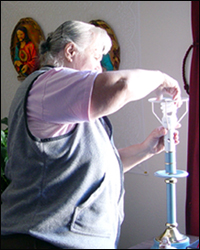| weatherization: overview |
Why is weatherization important? Reduced energy consumption - Residential buildings account for roughly 20 percent of our nation's energy use and greenhouse gas emissions. [3] Newer homes tend to be much more efficient than older ones, largely because of new building technologies and more stringent code requirements in recent years. As households age, however, so do their homes: According to the American Housing Survey, among householders age 65+, more than 70 percent own or rent homes built prior to 1980. [4] Weatherization can help to reduce energy use in these older structures, advancing the nation's climate change objectives while also resulting in other important benefits for older adults. Reduced energy cost burden - Low-income older consumers, many of whom may be living on a fixed income, tend to use less heating fuel than their higher-income neighbors but, because of their financial situations, are nonetheless burdened by these lower costs. [5] When the household budget gets stretched too thin, older adults may be faced with difficult choices and forced to make trade-offs between paying the utility bill and paying for other essentials. A recent survey found that in the preceding twelve months, nearly 29 percent of households with older adults had to choose between paying for food and paying for utilities or heating fuel. [6] While many older adults benefit from programs that provide assistance making monthly utility bill payments, these are only temporary fixes and often depend on the availability of government funding. When done correctly, home weatherization promises to lower home heating and cooling costs for years to come. Improved health outcomes - To avoid high bills in homes that have not been weatherized, some families rely on unsafe methods to heat their homes. The use of kerosene heaters and stoves to provide warmth, for example, can produce gases that may cause asphyxiation. Electric heaters that have not been properly insulated can result in burns and fires. There is also evidence that cold indoor temperatures and drafts in unweatherized homes may contribute to asthma and other respiratory diseases. Inadequate cooling can also be hazardous, with extreme heat resulting in death in some cases. In addition to freeing up money in the budget for food, medication, and other essentials, weatherization can help to remedy these conditions and create a healthier indoor living environment. [7] Where is weatherization most applicable? | Solutions in Action |
 In 2004, Vincent House, a federally-assisted senior complex in Seattle, WA, received a $6.3 million HUD Section 202 rehabilitation grant to undertake a significant renovation including energy enhancements that are expected to save tenants nearly $100 a year in utility costs. On top of the federal assistance, the city agreed to donate nearly $40,000 to make certain energy enhancements, including adding energy-efficient lighting, thermostats, and refrigerators to all of the units. Residents also received four Energy Star lightbulbs from the City of Seattle and City Light, the public utility company, as part of the Change a Light, Change the World campaign, an effort of the EPA, Department of Energy, and HUD to promote energy-efficiency and conservation throughout the nation. Case study and image courtesy of the National Housing Trust. |
 Learn more about challenges associated with weatherizing homes and resources available to address these challenges Learn more about challenges associated with weatherizing homes and resources available to address these challenges Go back to learn about other tools that help to provide accessible, safe, and affordable homes Go back to learn about other tools that help to provide accessible, safe, and affordable homes |